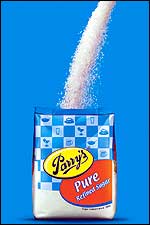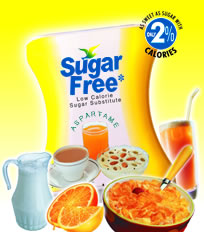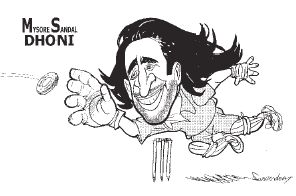Company: EID Parry
Agency: JWT
Brand Count : 152
Indian sugar industry is worth a whopping Rs 25000 crore. Although India is the second largest producer of sugar in the world, the percapita consumption is low at 18 kg.Unlike the Salt industry which saw many successful branded players, the branded sugars were not that successful.
successful branded players, the branded sugars were not that successful.
Sugar branding was initiated around 6 years ago by players like Mawana sugars and Dhampur sugars. The first movers got the advantage and these players now have a 30 percent market share in the branded sugar segment. November 2004 saw EID Parrys launching their brand Parry's Sugar in TamilNadu which is traditionally a big market for sugar.
Although the market size of sugar industry is large, 75% of the sugar is consumed by large buyers like bakeries, Soft drink manufacturers and confectionery players. Hence most of the marketing is business to business.
The sugar industry has two types of pricing models. One is the free market pricing and the other regulated pricing through public distribution systems. The sugar prices are monitored by the government which sometimes intervene in the market and regulate prices through imports ( if the price increases )
Sugar is viewed by consumers as a commodity and there has not been any initiative from the part of sugar companies to create a differentiation compared to what marketers have done with Salts. Parry's has launced its branded sugar with focus on its quality and purity. It is known fact that the best way to brand a commodity is to focus of these two attributes. Parry's claims to be better refined and pure than the unbranded sugar. Packed in attractive pet bottles, the brand sells at a premium of Rs 4- 6 over the unbranded ones.
The market for sugar is a highly price sensitive one. While in the case of salt, the presence of Iodine was a sufficient differentiation for establishing the brand. The Iodine deficiency could cause thyroid and customers were educated by the government and the salt marketers to prefer iodised salt . But in the case of sugar, those differentiation opportunities were absent. According to a report in Business Today there are different factors that caused the slow start of branded sugars . They are
a.Seasonality : sugar production is seasonal and the entire years productions should be completed within 5-6 months. Hence there is no time for product or process innovations.
b. The sugar play is high volume low margin game. Hence whether marketers are interested in exploring the value added game is another factor that slows down the growth of branded sugar market. While branding involves promotional costs, it will be a tough tradeoff since margin pressure will prevent aggressive brand promotions.
c. The large format retailers have also started selling packed sugar with a premium of 50 paise to Rs 1 making the consumers think that the packed sugars are better refined than the other one.
The main factor behind the branded sugar becoming less popular is the lack of differentiation. The reasons are not compelling for consumers to shell out a premium for branded sugars. Even though Quality and Purity is an issue with the unbranded sugars, even affluent consumers are shying away from paying a premium for branded sugars. More over some branded sugars use sulphur dioxide to refine which is harmful and this type of refining is banned in European countries. It is said that in the west, marketers try to value add this commodity by enriching it with vitamins .
Branding a commodity always has been a challenging task for marketers. Parry's Sugar is a brand to watch and it will be interesting to see how this brand breaks into the consumer psyche.
source:magindia,eidparry,businesstoday,chennaionline,jimtrade,agencyfaqs
 successful branded players, the branded sugars were not that successful.
successful branded players, the branded sugars were not that successful.Sugar branding was initiated around 6 years ago by players like Mawana sugars and Dhampur sugars. The first movers got the advantage and these players now have a 30 percent market share in the branded sugar segment. November 2004 saw EID Parrys launching their brand Parry's Sugar in TamilNadu which is traditionally a big market for sugar.
Although the market size of sugar industry is large, 75% of the sugar is consumed by large buyers like bakeries, Soft drink manufacturers and confectionery players. Hence most of the marketing is business to business.
The sugar industry has two types of pricing models. One is the free market pricing and the other regulated pricing through public distribution systems. The sugar prices are monitored by the government which sometimes intervene in the market and regulate prices through imports ( if the price increases )
Sugar is viewed by consumers as a commodity and there has not been any initiative from the part of sugar companies to create a differentiation compared to what marketers have done with Salts. Parry's has launced its branded sugar with focus on its quality and purity. It is known fact that the best way to brand a commodity is to focus of these two attributes. Parry's claims to be better refined and pure than the unbranded sugar. Packed in attractive pet bottles, the brand sells at a premium of Rs 4- 6 over the unbranded ones.
The market for sugar is a highly price sensitive one. While in the case of salt, the presence of Iodine was a sufficient differentiation for establishing the brand. The Iodine deficiency could cause thyroid and customers were educated by the government and the salt marketers to prefer iodised salt . But in the case of sugar, those differentiation opportunities were absent. According to a report in Business Today there are different factors that caused the slow start of branded sugars . They are
a.Seasonality : sugar production is seasonal and the entire years productions should be completed within 5-6 months. Hence there is no time for product or process innovations.
b. The sugar play is high volume low margin game. Hence whether marketers are interested in exploring the value added game is another factor that slows down the growth of branded sugar market. While branding involves promotional costs, it will be a tough tradeoff since margin pressure will prevent aggressive brand promotions.
c. The large format retailers have also started selling packed sugar with a premium of 50 paise to Rs 1 making the consumers think that the packed sugars are better refined than the other one.
The main factor behind the branded sugar becoming less popular is the lack of differentiation. The reasons are not compelling for consumers to shell out a premium for branded sugars. Even though Quality and Purity is an issue with the unbranded sugars, even affluent consumers are shying away from paying a premium for branded sugars. More over some branded sugars use sulphur dioxide to refine which is harmful and this type of refining is banned in European countries. It is said that in the west, marketers try to value add this commodity by enriching it with vitamins .
Branding a commodity always has been a challenging task for marketers. Parry's Sugar is a brand to watch and it will be interesting to see how this brand breaks into the consumer psyche.
source:magindia,eidparry,businesstoday,chennaionline,jimtrade,agencyfaqs









